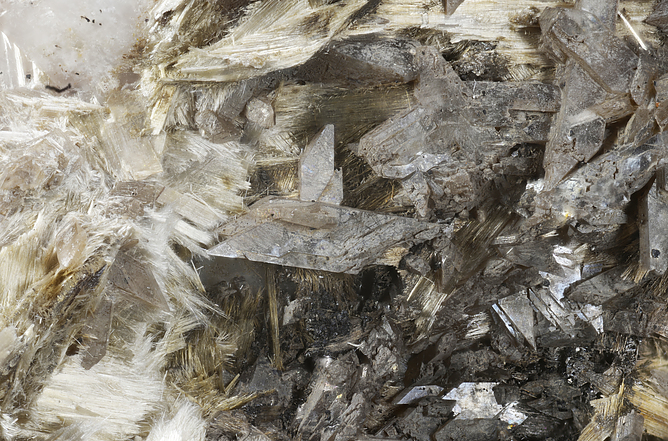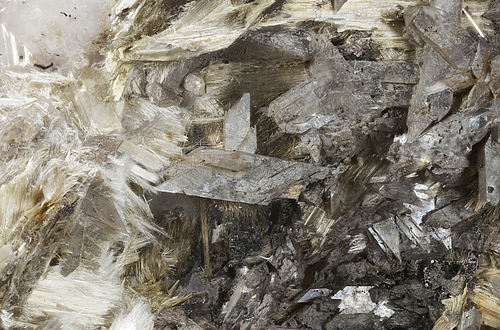Mooreite
A valid IMA mineral species - grandfathered
This page is currently not sponsored. Click here to sponsor this page.
About Mooreite
Formula:
Mg9◻2Mn2Zn4(SO4)2(OH)26 · 8H2O
Colour:
Colourless, light tan; colourless in transmitted light.
Lustre:
Sub-Vitreous, Pearly
Hardness:
3
Specific Gravity:
2.47
Crystal System:
Monoclinic
Name:
Named in 1929 by Lawson H. Bauer and Harry Berman in honor of Gideon Emmet Moore [August 21, 1842 New York, New York, USA - April 13, 1895 New York, New York, USA], American chemist, originally an assayer at Virginia City, Nevada, USA and worked mostly with the Passaic Zinc Company (1872-1895), and who early investigated the minerals of Sterling Hill and Franklin, New Jersey. He named brushite, chalcophanite, cryptokallite, hetaerolite, and the first natural occurrence of metacinnabarite.
This page provides mineralogical data about Mooreite.
Unique Identifiers
Mindat ID:
2775
Long-form identifier:
mindat:1:1:2775:1
GUID
(UUID V4):
(UUID V4):
98c5333e-bb01-4528-9eb3-aa832ff7c031
IMA Classification of Mooreite
Approved, 'Grandfathered' (first described prior to 1959)
IMA Formula:
Mg15(SO4)2(OH)26 · 8H2O
First published:
1929
Classification of Mooreite
7.DD.45
7 : SULFATES (selenates, tellurates, chromates, molybdates, wolframates)
D : Sulfates (selenates, etc.) with additional anions, with H2O
D : With only medium-sized cations; sheets of edge-sharing octahedra
7 : SULFATES (selenates, tellurates, chromates, molybdates, wolframates)
D : Sulfates (selenates, etc.) with additional anions, with H2O
D : With only medium-sized cations; sheets of edge-sharing octahedra
31.1.3.1
31 : HYDRATED SULFATES CONTAINING HYDROXYL OR HALOGEN
1 : (AB)m(XO4)pZq·xH2O, where m:p > 6:1
31 : HYDRATED SULFATES CONTAINING HYDROXYL OR HALOGEN
1 : (AB)m(XO4)pZq·xH2O, where m:p > 6:1
25.9.10
25 : Sulphates
9 : Sulphates of Mn
25 : Sulphates
9 : Sulphates of Mn
Mineral Symbols
As of 2021 there are now IMA–CNMNC approved mineral symbols (abbreviations) for each mineral species, useful for tables and diagrams.
| Symbol | Source | Reference |
|---|---|---|
| Mre | IMA–CNMNC | Warr, L.N. (2021). IMA–CNMNC approved mineral symbols. Mineralogical Magazine, 85(3), 291-320. doi:10.1180/mgm.2021.43 |
Pronunciation of Mooreite
Pronunciation:
| Play | Recorded by | Country |
|---|---|---|
| Jolyon Ralph | United Kingdom |
Physical Properties of Mooreite
Sub-Vitreous, Pearly
Transparency:
Transparent
Comment:
Pearly on cleavage
Colour:
Colourless, light tan; colourless in transmitted light.
Streak:
White to colorless
Hardness:
3 on Mohs scale
Tenacity:
Flexible
Cleavage:
Perfect
On {010}, perfect.
On {010}, perfect.
Fracture:
Micaceous
Density:
2.47 g/cm3 (Measured) 2.54 g/cm3 (Calculated)
Optical Data of Mooreite
Type:
Biaxial (-)
RI values:
nα = 1.533 nβ = 1.545 nγ = 1.547
2V:
Measured: 50° to 50°
Birefringence:
0.014
Max Birefringence:
δ = 0.014

Image shows birefringence interference colour range (at 30µm thickness)
and does not take into account mineral colouration.
and does not take into account mineral colouration.
Surface Relief:
Low
Dispersion:
weak
Optical Extinction:
X=b, Z^c =44°
Chemistry of Mooreite
Mindat Formula:
Mg9◻2Mn2Zn4(SO4)2(OH)26 · 8H2O
Crystallography of Mooreite
Crystal System:
Monoclinic
Class (H-M):
2/m - Prismatic
Space Group:
P2/b
Cell Parameters:
a = 11.147 Å, b = 20.350 Å, c = 8.202 Å
β = 92.7°
β = 92.7°
Ratio:
a:b:c = 0.548 : 1 : 0.403
Unit Cell V:
1,858.49 ų (Calculated from Unit Cell)
Z:
2
Morphology:
Crystals tabular to platy {010}. Frequently as sub-parallel aggregates grouped on {010}.
Comment:
P21/a
Crystal Structure
Load
Unit Cell | Unit Cell Packed
2x2x2 | 3x3x3 | 4x4x4
Unit Cell | Unit Cell Packed
2x2x2 | 3x3x3 | 4x4x4
Show
Big Balls | Small Balls | Just Balls | Spacefill
Polyhedra Off | Si Polyhedra | All Polyhedra
Remove metal-metal sticks
Big Balls | Small Balls | Just Balls | Spacefill
Polyhedra Off | Si Polyhedra | All Polyhedra
Remove metal-metal sticks
Display Options
Black Background | White Background
Perspective On | Perspective Off
2D | Stereo | Red-Blue | Red-Cyan
Black Background | White Background
Perspective On | Perspective Off
2D | Stereo | Red-Blue | Red-Cyan
View
CIF File Best | x | y | z | a | b | c
CIF File Best | x | y | z | a | b | c
Rotation
Stop | Start
Stop | Start
Labels
Console Off | On | Grey | Yellow
Console Off | On | Grey | Yellow
Data courtesy of the American Mineralogist Crystal Structure Database. Click on an AMCSD ID to view structure
| ID | Species | Reference | Link | Year | Locality | Pressure (GPa) | Temp (K) |
|---|---|---|---|---|---|---|---|
| 0009711 | Mooreite | Hill R J (1980) The structure of mooreite Acta Crystallographica B36 1304-1311 |  | 1980 | Sterling Hill, New Jersey, USA | 0 | 293 |
CIF Raw Data - click here to close
X-Ray Powder Diffraction
Image Loading
Radiation - Copper Kα
Data courtesy of RRUFF project at University of Arizona, used with permission.
Powder Diffraction Data:
| d-spacing | Intensity |
|---|---|
| 10.1 Å | (80) |
| 5.08 Å | (100) |
| 3.45 Å | (50) |
| 2.67 Å | (40) |
| 2.38 Å | (80) |
| 1.732 Å | (50) |
| 1.619 Å | (60) |
| 1.546 Å | (30) |
Comments:
ICDD 43-696; Note: Mooreite and torreyite differ in structure, although they are chemically similar.
Geological Environment
Paragenetic Mode(s):
| Paragenetic Mode | Earliest Age (Ga) |
|---|---|
| High-𝑇 alteration and/or metamorphism | |
| 32 : Ba/Mn/Pb/Zn deposits, including metamorphic deposits | |
| Stage 7: Great Oxidation Event | <2.4 |
| 47a : [Near-surface hydration of prior minerals] | |
| 47b : [Sulfates and sulfites] |
Type Occurrence of Mooreite
Geological Setting of Type Material:
Fracture fillings in calcite-willemite-franklinite ore
Reference:
Bauer, L.H., Berman, H. (1929) Mooreite, a new mineral and fluoborite from Sterling Hill, New Jersey. American Mineralogist: 14: 165-172.
Other Language Names for Mooreite
Common Associates
Associated Minerals Based on Photo Data:
| 26 photos of Mooreite associated with Pyrochroite | Mn(OH)2 |
| 16 photos of Mooreite associated with Torreyite | (Mg,Mn2+)7◻2Mn2+2Zn4(SO4)2(OH)22 · 8H2O |
| 14 photos of Mooreite associated with Rhodochrosite | MnCO3 |
| 11 photos of Mooreite associated with Fluoborite | Mg3(BO3)(F,OH)3 |
| 9 photos of Mooreite associated with Willemite | Zn2SiO4 |
| 8 photos of Mooreite associated with Zincite | ZnO |
| 7 photos of Mooreite associated with Sussexite | Mn2+BO2(OH) |
| 4 photos of Mooreite associated with Lawsonbauerite | (Mn2+,Mg)9Zn4(SO4)2(OH)22 · 8H2O |
| 4 photos of Mooreite associated with Franklinite | Zn2+Fe3+2O4 |
| 3 photos of Mooreite associated with Hauckite | Fe3+3(Mg,Mn2+)24Zn18(SO4)4(CO3)2(OH)81 |
Related Minerals - Strunz-mindat Grouping
| 7.DD. | Asagiite | NiCu4(SO4)2(OH)6 · 6H2O |
| 7.DD.05 | Felsőbányaite | Al4(SO4)(OH)10 · 4H2O |
| 7.DD.07 | Llantenesite | Cu6Al[SeO4](OH)12Cl · 3H2O |
| 7.DD.10 | Langite | Cu4(SO4)(OH)6 · 2H2O |
| 7.DD.10 | Posnjakite | Cu4(SO4)(OH)6 · H2O |
| 7.DD.10 | Wroewolfeite | Cu4(SO4)(OH)6 · 2H2O |
| 7.DD.10 | Gobelinite | CoCu4(SO4)2(OH)6 · 6H2O |
| 7.DD.10 | Fehrite | MgCu4(SO4)2(OH)6 · 6H2O |
| 7.DD.15 | Spangolite | Cu6Al(SO4)(OH)12Cl · 3H2O |
| 7.DD.15 | Kobyashevite | Cu5(SO4)2(OH)6 · 4H2O |
| 7.DD.15 | Unnamed (Dimorph of Devilline) | CaCu4(SO4)2(OH)6 · 3H2O |
| 7.DD.20 | Ktenasite | ZnCu4(SO4)2(OH)6 · 6H2O |
| 7.DD.25 | Christelite | Cu2Zn3(SO4)2(OH)6 · 4H2O |
| 7.DD.30 | Campigliaite | Mn2+Cu4(SO4)2(OH)6 · 4H2O |
| 7.DD.30 | Devilline | CaCu4(SO4)2(OH)6 · 3H2O |
| 7.DD.30 | Orthoserpierite | Ca(Cu,Zn)4(SO4)2(OH)6 · 3H2O |
| 7.DD.30 | Serpierite | Ca(Cu,Zn)4(SO4)2(OH)6 · 3H2O |
| 7.DD.30 | Niedermayrite | CdCu4(SO4)2(OH)6 · 4H2O |
| 7.DD.30 | Edwardsite | Cu3Cd2(SO4)2(OH)6 · 4H2O |
| 7.DD.35 | Carrboydite | (Ni1-xAlx)(SO4)x/2(OH)2 · nH2O |
| 7.DD.35 | Glaucocerinite | (Zn1-xAlx)(OH)2(SO4)x/2 · nH2O |
| 7.DD.35 | Honessite | (Ni1-xFe3+x)(OH)2[SO4]x/2 · nH2O |
| 7.DD.35 | Hydrohonessite | (Ni1-xFe3+x)(OH)2(SO4)x/2 · nH2O |
| 7.DD.35 | Motukoreaite | Mg6Al3(OH)18[Na(H2O)6][SO4]2 · 6H2O |
| 7.DD.35 | Mountkeithite | [(Mg1-xFe3+x)(OH)2][SO4]x/2 · nH2O |
| 7.DD.35 | Shigaite | Mn6Al3(OH)18[Na(H2O)6](SO4)2 · 6H2O |
| 7.DD.35 | Wermlandite | Mg7Al2(OH)18[Ca(H2O)6][SO4]2 · 6H2O |
| 7.DD.35 | Woodwardite | Cu1-xAlx(OH)2(SO4)x/2 · nH2O |
| 7.DD.35 | Zincaluminite | Zn6Al6(SO4)2(OH)16 · 5H2O |
| 7.DD.35 | Hydrowoodwardite | (Cu1-xAlx)(OH)2[SO4]x/2 · nH2O |
| 7.DD.35 | Zincowoodwardite | Zn1-xAlx(OH)2[SO4]x/2 · nH2O |
| 7.DD.35 | Natroglaucocerinite | Zn6Al3(OH)18[Na(H2O)6](SO4)2 · 6H2O |
| 7.DD.35 | Nikischerite | Fe2+6Al3(OH)18[Na(H2O)6](SO4)2 · 6H2O |
| 7.DD.40 | Isselite | Cu6(SO4)(OH)10 · 5H2O |
| 7.DD.40 | Lawsonbauerite | (Mn2+,Mg)9Zn4(SO4)2(OH)22 · 8H2O |
| 7.DD.40 | Torreyite | (Mg,Mn2+)7◻2Mn2+2Zn4(SO4)2(OH)22 · 8H2O |
| 7.DD.45 | Hodgesmithite | (Cu,Zn)6Zn(SO4)2(OH)10 · 3H2O |
| 7.DD.47 | Lahnsteinite | Zn4(SO4)(OH)6 · 3H2O |
| 7.DD.50 | Namuwite | Zn4(SO4)(OH)6 · 4H2O |
| 7.DD.50 | Minohlite | (Cu,Zn)7(SO4)2(OH)10 · 8H2O |
| 7.DD.52 | Lauraniite | Cu6Cd2(SO4)2(OH)12 · 5H2O |
| 7.DD.55 | Bechererite | Zn7Cu(OH)13[(SiO(OH)3(SO4)] |
| 7.DD.60 | Ramsbeckite | (Cu,Zn)15(SO4)4(OH)22 · 6H2O |
| 7.DD.65 | Vonbezingite | Ca6Cu3(SO4)3(OH)12 · 2H2O |
| 7.DD.70 | Redgillite | Cu6(SO4)(OH)10 · H2O |
| 7.DD.75 | Chalcoalumite | CuAl4(SO4)(OH)12 · 3H2O |
| 7.DD.75 | Nickelalumite | NiAl4(SO4)(OH)12(H2O)3 |
| 7.DD.75 | Kyrgyzstanite | ZnAl4(SO4)(OH)12 · 3H2O |
| 7.DD.80 | Guarinoite | Zn6(SO4)(OH)10 · 5H2O |
| 7.DD.80 | Schulenbergite | (Cu,Zn)7(SO4)2(OH)10 · 3H2O |
| 7.DD.80 | Thérèsemagnanite | NaCo4(SO4)(OH)6Cl · 6H2O |
| 7.DD.80 | UM1992-30-SO:CCuHZn | (Zn,Cu)7(SO4,CO3)2(OH)10 · 3H2O |
| 7.DD.85 | Montetrisaite | Cu6(SO4)(OH)10 · 2H2O |
Other Information
Notes:
Soluble in acids.
Health Risks:
No information on health risks for this material has been entered into the database. You should always treat mineral specimens with care.
Internet Links for Mooreite
mindat.org URL:
https://www.mindat.org/min-2775.html
Please feel free to link to this page.
Please feel free to link to this page.
Search Engines:
External Links:
Mineral Dealers:
References for Mooreite
Reference List:
Bauer, L. H., Berman, Harry (1929) Mooreite, a new mineral, and fluoborite from Sterling Hill, New Jersey. American Mineralogist, 14 (5) 165-172
Prewitt-Hopkins, Joan (1949) X-ray study of holdenite, mooreite and torreyite. American Mineralogist, 34 (7-8) 589-595
Treiman, A. H., Peacor, D. R. (1982) The crystal structure of lawsonbauerite, (Mn,Mg)9Zn4(SO4)2(OH)22·8H2O, and its relation to mooreite. American Mineralogist, 67 (9-10) 1029-1034
Localities for Mooreite
Locality List
 - This locality has map coordinates listed.
- This locality has map coordinates listed.
 - This locality has estimated coordinates.
ⓘ - Click for references and further information on this occurrence.
? - Indicates mineral may be doubtful at this locality.
- This locality has estimated coordinates.
ⓘ - Click for references and further information on this occurrence.
? - Indicates mineral may be doubtful at this locality.
 - Good crystals or important locality for species.
- Good crystals or important locality for species.
 - World class for species or very significant.
(TL) - Type Locality for a valid mineral species.
(FRL) - First Recorded Locality for everything else (eg varieties).
- World class for species or very significant.
(TL) - Type Locality for a valid mineral species.
(FRL) - First Recorded Locality for everything else (eg varieties).
All localities listed without proper references should be considered as questionable.
Germany | |
| Weiß (1990) |
USA (TL) | |
| Palache (1935) +5 other references |
| Peter Chin |
Quick NavTopAbout MooreiteUnique IdentifiersIMA Classification Classification Mineral SymbolsPronunciation Physical Properties Optical Data Chemistry Crystallography Crystal StructureX-Ray Powder DiffractionGeological EnvironmentType Occurrence Other LanguagesCommon AssociatesStrunz-MindatOther InformationInternet Links References Localities Locality List






 symbol to view information about a locality.
The
symbol to view information about a locality.
The 




Sterling Mine, Sterling Hill, Ogdensburg, Sussex County, New Jersey, USA